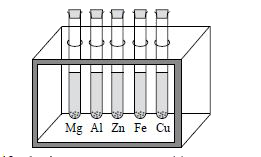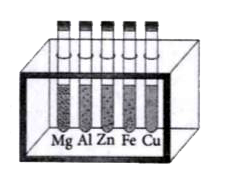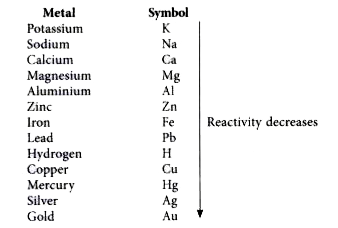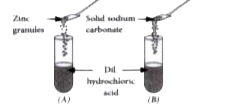Abhiruchi, a class 10 student took clean small pieces of magnesium, aluminium, zinc, iron and copper in separate test tubes. She added about 10 mL of dilute hydrochloric acid to each of them.

Identify the incorrect statement(s).
The rate of evolution of hydrogen gas bubbles is same in all the test tubes as all are metals.
The reactivity decreases in the order :
In case of copper, no bubbles are seen and the temperature also remains unchanged.
Both A and B.
The correct Answer is:D
Step by step video, text & image solution for Abhiruchi, a class 10 student took clean small pieces of magnesium, aluminium, zinc, iron and copper in separate test tubes. She added about 10 mL of dilute hydrochloric acid to each of them. Identify the incorrect statement(s). by Chemistry experts to help you in doubts & scoring excellent marks in Class 10 exams.
Updated on:21/07/2023Topper's Solved these Questions
- NSO QUESTION PAPER 2018 SET BBOOK - SCIENCE OLYMPIAD FOUNDATION CHAPTER - NSO QUESTION PAPER 2018 SET BEXERCISE - ACHIEVERS SECTION
2 Videos
- NSO QUESTION PAPER 2018 SET ABOOK - SCIENCE OLYMPIAD FOUNDATION CHAPTER - NSO QUESTION PAPER 2018 SET AEXERCISE - Achievers Section
2 Videos
- NSO QUESTION PAPER 2019 SET ABOOK - SCIENCE OLYMPIAD FOUNDATION CHAPTER - NSO QUESTION PAPER 2019 SET AEXERCISE - ACHIEVERS SECTIONS
1 Videos
Similar Questions
Harish took metal samples of Fe,Zn,Al,Cu and Pb in separate test tube. And added hydrochloric acid in each of them.
(b) Which metals reacted vigorously with dilute hydrochloric acid.
View SolutionHarish took metal samples of Fe,Zn,Al,Cu and Pb in separate test tube. And added hydrochloric acid in each of them.
(a) Arrange the metals in the decreasing order of their reactivity.
View Solution
Knowledge Check
Clean small pieces of magnesium, zinc, aluminium, iron and copper by rubbing them with a piece of sand paper. Take them in separate test tubes. Add about 10 mL of dilute hydrochloric acid to each of them.

Consider the following statements.
(i) The rate of evolution of hydrogen gas bubbles is not same in all the test tubes.
(ii) The rate of formation of bubbles is the fastest in the case of magnesium.
(iii) The reactivity decreases in the order:
Mg>Zn>Al>Fe>Cu.
(iv) In the case of copper, no bubbles are seen and the temperature also remains unchanged. This shows that copper does not react with dilute HCl.
Identify the correct option.AOnly (i) and (iv)BOnly (iii) and (iv)COnly (iii)DOnly (i), (ii) and (iv)Some materials like magnesium ribbon, aluminium foil, copperr wire and charcoal (powder) were taken in different test tubes labelled as P, Q, R and S. 5 mL of dilute hydrochloric acid was added to each test tube. When a burning matchstick is brought near the mouth of each test tube, in which cases pop sound would be heard ?
AOnly PBOnly P and QCOnly Q and SDOnly P, Q and RA student took some zinc granules a test tube and added dilute hydrochloric acid to it. A colourless, odourless gas X was evolved .The gas X is:
AHydrogenBOxygenCCarbon dioxideDNitrogen dioxide
Harish took metal samples of Fe,Zn,Al,Cu and Pb in separate test tube. And added hydrochloric acid in each of them.
Write balanced chemical reaction with Al and Zn with dilute hydrochloric acid.
View SolutionA student addd few pieces of aluminium metal to two test tubes A and B containing aqueous solutions of iron sulphate and copper sulphate. In the second part of her experiment, the added iron metal to another test tubes C and D containing aqueous solutions of aluminium sulphate and copper sulphate.
In which test tube or test tubes will she observe colour change? On the basis of this experiment, state which one is the most reactive metal and why ?
View SolutionMetals in general have a tendency to evolve hydrogen gas o reacting with acids. In the activity series the metals that are placed above hydrogen evolve the gas on reaction with acids while the metals placed below hydrogen do not evolve the gas on reaction with acids. these metals are regarded as inactive metals. metals placed at the bottom of the series are called noble metals.
Pieces of copper, lead, aluminium and zinc are added to dilute hydrochloric acid. which of the following test tubes most likely contains zinc ?

View SolutionMost of the metals react chemically with other substances in one form or another. Few metals which do not react with common chemicals are called noble metals e.g., silver, gold, platinum. The rate of reaction with which metals react is not same for all the metals. The rate of reaction depends on the reactivity of metals. On the basis of their reactive nature, a series known as reactivity series has been drawn in which metals are arranged in decreasing order of their reactivity.

Pieces of copper, lead, aluminium and zinc are added to dilute hydrochloric acid. Which of the following test tubes most likely contains zinc?

View SolutionA student took two test tubes, (A) and (B) containing 2 mL of dilute hydrochloric acid and added zinc granules to test tube (A) and solid sodium carbonate to test tube (B) as shown below:

The correct observation would be
View Solution
